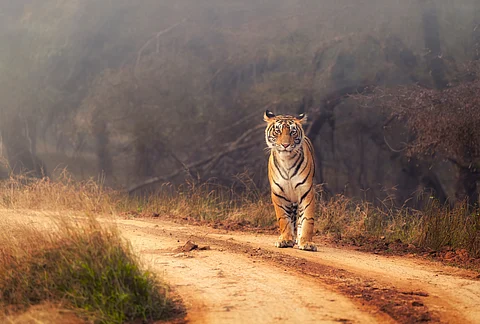
- Destinations
- Experiences
- Stay
- What's new
- Celebrating People
- Responsible Tourism
- CampaignsCampaigns
- Subscribe
- Buy Now

Following this year's monsoon season, India is set to airlift six of its Royal Bengal tigers to Cambodia in a historic step towards conservation of wildlife globally. The project aims to repopulate the jungles of Cambodia with the apex predator once again. Notably, tigers have been listed as functionally extinct in Cambodia since 2016. The wildlife partnership demonstrates the country's dedication to preserve its natural heritage as well as India's leadership qualities in tiger protection.
The Tatai Wildlife Sanctuary and the Cardamom Mountains in southwest Cambodia are the main targets of the reintroduction strategy. Because of its thick forests and initiatives to increase prey populations, this location has been deemed acceptable. With assistance from the Wildlife Institute of India (WII) and India's National Tiger Conservation Authority (NTCA), Cambodia has been improving habitat conditions, stepping up anti-poaching efforts, and interacting with local communities over the past four years.
Six tigers—two males and four females—will be transported to Cambodia from India's Western Ghats as part of the present plan. These tigers will be brought inside the Tatai Wildlife Sanctuary's 90-hectare protected area. This location was chosen because it is ecologically suitable and has a sufficient number of prey species. In order to provide the best conditions for the tigers' adaptation, the transfer is planned for post-monsoon months, most likely in November or December.
Despite being revolutionary, the program has drawbacks. Important issues include ensuring the tigers adjust to their new surroundings, avoiding conflicts between people and wildlife, and preserving genetic variety. In order to properly handle these concerns, both nations are dedicated to following the international standards established by the International Union for Conservation of Nature (IUCN).
In 2007, the last remaining wild tiger in Cambodia was sighted in the Mondulkiri province in the east. The species' demise in the nation was caused by decades of poaching, habitat damage and illicit wildlife trading. Ever since, Cambodia—having recognised the ecological gap created by the loss of the apex predator—has been in an endeavour to create an optimal environment that will allow the big cats to return.
With programs like Project Tiger, India, which is home to more than 70 percent of the world's wild tiger population regardless of its recent brutal history with the wild cats, has taken the lead in tiger conservation. Currently home to about 3,682 tigers, India's achievement is a role model for other countries. India's choice to support Cambodia is consistent with its larger commitment to the conservation of biodiversity worldwide.
If this relocation is successful, it may improve global conservation cooperation and open the door for future species reintroductions. Additionally, it has the potential to increase ecotourism in Cambodia by giving local populations financial advantages and additional incentives for protecting animals.
